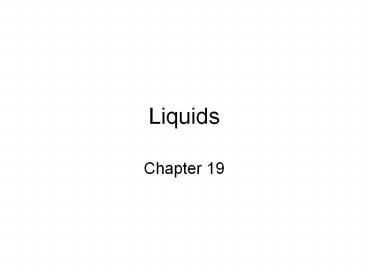Liquids PowerPoint PPT Presentation
1 / 25
Title: Liquids
1
Liquids
- Chapter 19
2
Liquids
- While in the liquid phase, a substance will take
the shape of their container, but will not expand
to fill the container. - In the liquid state, molecules can flow. They
freely move from place to place by sliding over
one another.
3
Pressure in Liquids
- Any contained fluid exerts a force on the walls
of its container. The ratio of this force to the
surface area of the container is called pressure. - F
- P A
- The unit for pressure is the Newton per meter
squared, or the Pascal.
4
Pressure in Liquids
- In a fluid, pressure is exerted equally in all
directions. - Therefore, the pressure always acts perpendicular
to every surface.
5
Pressure in Liquids
- For a liquid of uniform density, the pressure is
proportional to the depth of measurement
6
Pressure in Liquids
- For a liquid of uniform density, the pressure is
proportional to the depth of measurement
Pressure weight density x depth Pressure
density x g x depth
7
Pressure in Liquids
- For a liquid of uniform density, the pressure is
proportional to the depth of measurement
Pressure density x g x depth
8
Pressure in Liquids
- Pascals Vases demonstrate that the pressure of
the liquid depends on the depth alone, and not
the volume or shape of the fluid.
9
Buoyancy
- When an object is placed in water, it weighs less
than it did in air. This is due to an upward
force exerted on the object by the water. - The upward force is called the buoyant force.
10
Buoyancy
- When an object is placed in water, it weighs less
than it did in air. This is due to an upward
force exerted on the object by the water. - The upward force is called the buoyant force.
11
Buoyancy
- If the buoyant force on an object is greater than
the weight, the object will float.
12
Archimedes Principle
- When an object is submerged in a liquid, some of
that liquid is displaced. - The volume of liquid displaced is equal to the
volume of the immersed object.
13
Archimedes Principle
- The Greek philosopher Archimedes determined the
relationship between buoyancy and the amount of
liquid displaced. - An immersed object is buoyed up by a force equal
to the weight of the fluid it displaces.
14
Archimedes Principle
15
Archimedes Principle
- The buoyant force depends on the volume of the
object that is being submerged in the fluid
nothing else matters. - For every liter of volume (or 1000 cm3), there is
a 10-newton buoyant force.
16
Archimedes Principle
- For example, what is the buoyant force on
- - a half liter block of wood?
- - a 100 milliliter brass weight?
- - a 2 liter bottle of ginger ale?
- - a 2 liter bottle half full of ginger ale?
- - a 2 liter bottle full of air?
17
Archimedes Principle
- The buoyant force acting on an object does not
depend on the depth of the water.
18
Density and Submersion
- Whether an object will sink or float in a liquid
has to do with how great the buoyant force is
compared to the objects weight. - This can be summed up with three simple rules
- If an object is denser than the fluid in which it
is immersed, it will sink. - If an object is less dense than the fluid in
which it is immersed, it will float. - If an object has a density equal to the density
of the fluid in which it is immersed, it will
neither sink nor float.
19
Flotation
- How can you make iron float?
- If the iron can be made less dense than water, it
will float. This can be done by filling the
piece of iron with pockets of air. - This can be done by making bubbles in the iron as
it cools, or by making a hollow object of iron.
20
Flotation
21
Flotation
- The Principle of Flotation
- A floating object displaces a weight of fluid
equal to its own weight. - For example, the aircraft carrier USS Enterprise
weighs 90,000 tons. - It displaces 90,000 tons of water.
22
(No Transcript)
23
Flotation
- To see how a submarine is able to make use of
this principle to submerge and then re-surface,
take a look at my website.
24
Pascals Principle
- Changes in pressure at any point in an enclosed
fluid at rest are transmitted undiminished to all
points in the fluid and act in all directions.
25
Homework
- Read ch 19 and do problems 1-20 on pages 280 and
281. - Due Monday, 3/6

